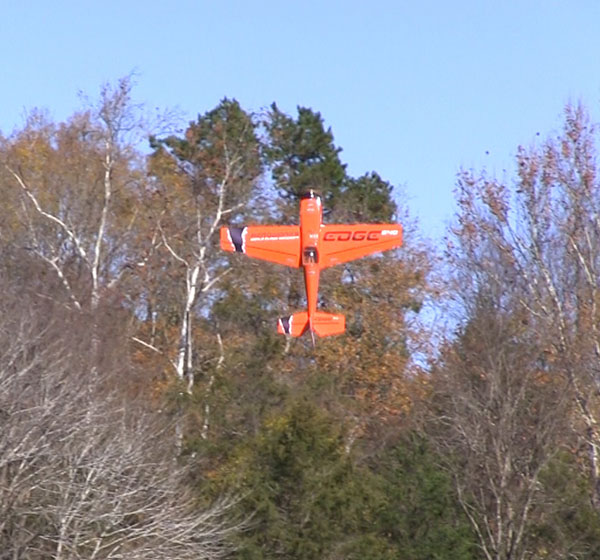



Hanging a plane on the prop looks impressive but can go terribly wrong due to
a small issue, like a loose engine mount.
Text, photos and video by Tom Hintz
Posted – 4-5-2016
The DLE61 engine powering my Aeroworks 50cc Edge 540 has been super dependable since I first installed it. For a couple years it has started easily, run smooth, idled reliably and produced gobbs of power on request. Then over the course of approximately 25 flights my trusty DLE61 started stumbling, missing and sounding like it had gone rich on the high end. The sound and performance continued to get worse even though I was making small adjustments to the high speed needle in attempts to lean the motor out.
At a recent fun fly I put the Aeroworks 50cc Edge 540 up for my first flight of the day and the missing and stumbling was worse than ever. Confusing the situation was that the DLE61 continued to start easily and idle well. Most of the people who heard it in flight agreed that it sounded rich. I decided to land it, lean the motor a bit more and install a new spark plug just in case.
The starting stands I usually use to work on my giant scale planes were full because of the large fun fly crowd so I put the Aeroworks 50cc Edge 540 on a work table that put the front cowl openings unusually high, at eye level. That turned out to be the stroke of luck I needed. As I was trying to get the plug wire off of the spark plug I noticed that the washer on the bottom left (looking from the front) engine mounting bolt was hanging down lower than the standoff and spacer. I poked the washer with a screwdriver and sure enough, that mounting bolt at the firewall was loose.
I removed the prop, cowl and top motor box cover to get at the firewall-side engine bolts. On the Aeroworks 50cc Edge 540 the DLE61 uses longer standoffs that have bolts on either end connecting the standoffs to the firewall and the engine to the standoffs on the other. When I opened the motor box I could see fine metallic dust inside that more than likely came from the now loose washer and ¼”-thick aluminum spacer vibrating against each other during flight.
I had used generous amounts of thread locker on these bolts and tightened them several times during construction to make sure that the washers had compressed the firewall wood as far as they were going to. I had also gone through the engine mount bolts after the first several flights to once again insure they were tight. Now when tightening the loose engine bolt it was difficult to turn but we did get nearly two turns on it before it stopped turning. I checked the other three engine bolts and could only turn those maybe ¼ turn. I re assembled the cowl and prop and put the Aeroworks 50cc Edge 540 back in my safety start. I am not sure if the offending bolt had loosened up or if the plywood firewall was a little softer at that bolt, allowing it to compress a little more than the others. I will keep an eye on it though.
While I was working on the loose bolt a couple friends that I listen to about motor issues said the excess vibration caused by the loose bolt could be at least partially responsible for the way the DLE61 was running recently. I wasn’t sure how a single loose bolt could cause the performance issues I had but I decided to put the Aeroworks 50cc Edge 540 back in the air without any carb adjustments or the new spark plug to see if the running issues were any different.
When I started the DLE61 it sounded healthy as ever. When I revved the motor it wound up cleanly which was also better than before tightening the bolt. When I opened the throttle for take-off it was obvious that the DLE61 was much happier because my Aeroworks 50cc Edge 540 once again jumped into the air as it always had before the now absent running issues had appeared. The stumble was gone and throughout the fight the DLE61 responded to throttle change cleanly.
Needless to say I was both happy and a little dumbfounded. It had never occurred to me that a slightly loose engine bolt (one of four) could change how the motor ran at speed. I really should not have been surprised because I’ve known for years that an out of balance prop can impact how a motor runs and the loose engine mount bolt was also creating a vibration. Just how that vibration makes the engine “run rich” or at least sound like it escapes me. Is it making bubbles in the fuel supply? Maybe but I am less interested in the physics right now and happier that my DLE61 is jerking my Aeroworks 50cc Edge 540 through the air with authority again and the “fix” didn’t cost anything!
All this just goes to show that we need to keep an open mind when tracking down a problem with our gas-powered planes. Our planes and their components are subjected to high levels of aerodynamic stress and vibrations that are constantly working to loosen things up and can even weaken critical parts of our airframes. We never really stop learning about our aircraft, including how to diagnose problems with them. We all know that gas engines vibrate, some more than others. However, that tendency in all gas engines means we need to make periodic checks to be sure the nuts and bolts remain tight. I already make the loose bolt inspections occasionally but I will be adding both ends of the engine mounts to that list for future inspections.
Have a comment on this story? –Email Me!